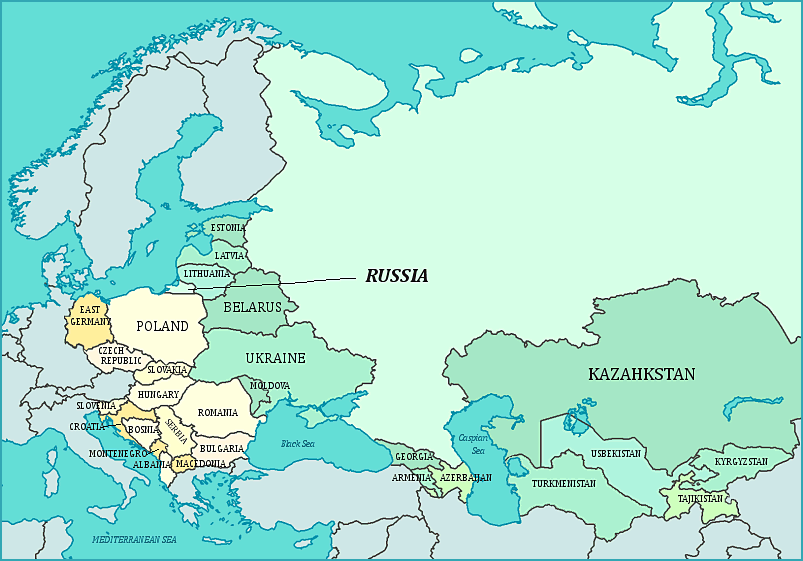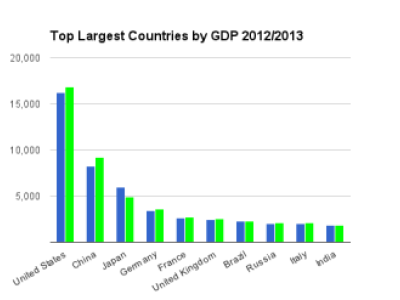In past I have created many GDP reviews regarding former Soviet Union republics, but have never made future GDP forecast report yet. In this article that's exactly what I'm doing.
Now, Soviet Union doesn't exist for more than 25 years already. Those former 15 republics have gone more or less separate way since dissolution of USSR.
There has happened some geopolitical changes over last 25 years, starting of dissolution of USSR, formation of CIS (Commonwealth of Independent States), three of former soviet republics have joined both European Union and NATO. And for a last of couple of years there has been attempts of trying to build up an Eurasian Union.

Map of Former Soviet Union (Source: Iron Curtain and Ex-U.S.S.R. Countries)
I will speak about those economical organizations seperatly latter in this post, but for now, let's take a look of Projected Future Forecast by International Monetary Fund for those former Soviet Union Countries
Projected Future Forecast For GDP (Nominal) In Former Soviet Union Block Countries (2014-2019)
| Country | 2014 bln $ | 2015 bln $ | 2016 bln $ | 2017 bln $ | 2018 bln $ | 2019 bln $ | % 5 years |
| Armenia | 11,111 | 11,465 | 11,780 | 12,387 | 13,304 | 14,318 | 28.86% |
| Azerbaijan | 77,913 | 85,439 | 91,629 | 98,771 | 106,601 | 113,995 | 46.31% |
| Belarus | 77,171 | 81,627 | 87,436 | 92,642 | 97,497 | 103,151 | 33.66% |
| Estonia | 26,363 | 27,410 | 29,158 | 31,123 | 33,204 | 35,495 | 34.63% |
| Georgia | 16,125 | 17,458 | 18,880 | 20,403 | 22,054 | 23,836 | 47.82% |
| Kazakhstan | 225,619 | 248,681 | 276,991 | 310,027 | 345,552 | 386,725 | 71.40% |
| Kyrgyzstan | 7,647 | 8,243 | 9,009 | 9,720 | 10,520 | 11,372 | 48.71% |
| Latvia | 32,815 | 34,118 | 36,138 | 38,703 | 41,362 | 44,222 | 34.76% |
| Lithuania | 48,722 | 51,002 | 54,462 | 58,481 | 62,750 | 67,375 | 38.28% |
| Moldova | 7,744 | 8,114 | 8,659 | 9,237 | 9,839 | 10,517 | 35.80% |
| Russia | 2,057,301 | 2,098,848 | 2,235,594 | 2,348,431 | 2,462,671 | 2,594,739 | 26.12% |
| Tajikistan | 9,156 | 9,690 | 10,592 | 11,595 | 12,644 | 13,848 | 51.24% |
| Turkmenistan | 47,542 | 54,237 | 62,559 | 71,105 | 80,020 | 90,155 | 89.63% |
| Ukraine | 134,885 | 136,067 | 148,457 | 163,675 | 179,807 | 196,271 | 45.50% |
| Uzbekistan | 63,079 | 67,888 | 74,575 | 81,567 | 89,219 | 97,590 | 54.71% |
| Total | 2,843,193 | 2,940,287 | 3,155,919 | 3,357,867 | 3,567,044 | 3,803,609 | 33.77% |
According to IMF, there will be 4 countries in next 5 years to increase their GDP by more than 50% - Turkmenistan (89.63%), Kazakhstan (71.40%) , Uzbekistan (54.71%) and Tajikistan (51.24%)
- While it may look as impressive growth of 51.24% for Tajikistan, it's overall GDP still will be very modest - up from $9,156 billion in 2014 to $13,84 billions in 2019. It's a growth of "just" $4.69 billions in 5 year term. Pretty modest result for a country with population 8.2 million.
- More slower, but still pretty decent results will show Russia (26.12%), Armenia (28.86%) and Belarus (33.65%). Speaking of Russia - for me those results seems surprisingly good, taking into account sanctions over Russia made both by EU and USA I was thinking the Russian economy for next 5 years will be with negative sign, but according to projected future of Russia's GDP, it wont decrease at all. If that's right I will be indeed surprised.
OK, at lets divide those 15 former Soviet countries in smaller blocks:
- Baltic States (Estonia, Latvia and Lithuania)
- South Caucasus (Georgia, Azerbaijan and Armenia)
- Central Asia (Kazakhstan, Turkmenistan, Tajikistan, Uzbekistan and Kyrgyzstan)
- Eurasian Union block countries (Russia, Kazakhstan, Belarus, Armenia and Kyrgyzstan).
What doesn't fit in any group those are Ukraine and Moldova. So I will group them into Eastern Partnership countries together with Georgia, Armenia, Azerbaijan and Belarus)
Baltic States Projected Future GDP (Nominal) (2014-2019)
| Country | 2014 $bln | 2015 $bln | 2016 $bln | 2017 $bln | 2018 $bln | 2019 $bln | % 5 years |
| Estonia | 26,363 | 27,410 | 29,158 | 31,123 | 33,204 | 35,495 | 34.63% |
| Latvia | 32,815 | 34,118 | 36,138 | 38,703 | 41,362 | 44,222 | 34.76% |
| Lithuania | 48,722 | 51,002 | 54,462 | 58,481 | 62,750 | 67,375 | 38.28% |
| Total | 107,900 | 112,530 | 119,758 | 128,307 | 137,316 | 147,092 | 36.32% |
Baltic states have been members to European Union and NATO since 2004. Since 2014 all countries have euro as national currency. In next 5 years Lithuania is projected to have biggest GDP increase of 38.28%, followed by Latvia (34.76%) and Estonia (34.63%)
- The total combined GDP of Baltic states will increase from $107,900 billions to $147,092 billions.
- What I can see from those data - Baltic's are united, they will experience modest but stable growth in next 5 years.
South Caucasus Projected Future GDP (Nominal) (2014-2019)
| Country | 2014 $bln | 2015 $bln | 2016 $bln | 2017 $bln | 2018 $bln | 2019 $bln | % 5 years | |
| Armenia | 11,111 | 11,465 | 11,780 | 12,387 | 13,304 | 14,318 | 28.86% | |
| Azerbaijan | 77,913 | 85,439 | 91,629 | 98,771 | 106,601 | 113,995 | 46.31% | |
| Georgia | 16,125 | 17,458 | 18,880 | 20,403 | 22,054 | 23,836 | 47.82% | |
| Total | 105,149 | 114,362 | 122,289 | 131,561 | 141,959 | 152,149 | 44.69% |
Situation in South Caucasus countries is pretty interesting - Armenia has joined Eurasian Union, Georgia is seeking it's way into European Union while Azerbaijan is trying to be neutral of choosing a larger geopolitical power. There are frozen conflict over disputed Nagorno-Karabakh region between Azerbaijan and Armenia.
My personal observation is simple - if Baltic states we can call more or less united, then situation is quite opposite here in Caucasus.
- In next five years region of South Caucasus is awaited to grow GDP by 44.69%
Central Asia Projected Future GDP (Nominal) (2014-2019)
| Country | 2014 $bln | 2015 $bln | 2016 $bln | 2017 $bln | 2018 $bln | 2019 $bln | % 5 years |
| Kazakhstan | 225,619 | 248,681 | 276,991 | 310,027 | 345,552 | 386,725 | 71.40% |
| Kyrgyzstan | 7,647 | 8,243 | 9,009 | 9,720 | 10,520 | 11,372 | 48.71% |
| Tajikistan | 9,156 | 9,690 | 10,592 | 11,595 | 12,644 | 13,848 | 51.24% |
| Turkmenistan | 47,542 | 54,237 | 62,559 | 71,105 | 80,020 | 90,155 | 89.63% |
| Uzbekistan | 63,079 | 67,888 | 74,575 | 81,567 | 89,219 | 97,590 | 54.71% |
| Total | 353,043 | 388,739 | 433,726 | 484,014 | 537,955 | 599,690 | 69.86% |
- Now, according to IMF Estimates region of Central Asia will experience most faster growth in former Soviet Union block making average 69.86% growth in next five years.
- The total output of combined GDP of Central Asia will increase from $0.35 trillions in 2014 to almost $0.6 trillions in 2019.
Eurasian Union Projected Future GDP (Nominal) (2014-2019)
| Country | 2014 $bln | 2015 $bln | 2016 $bln | 2017 $bln | 2018 $bln | 2019 $bln | % 5 years |
| Russia | 2,057,301 | 2,098,848 | 2,235,594 | 2,348,431 | 2,462,671 | 2,594,739 | 26.12% |
| Armenia | 11,111 | 11,465 | 11,780 | 12,387 | 13,304 | 14,318 | 28.86% |
| Belarus | 77,171 | 81,627 | 87,436 | 92,642 | 97,497 | 103,151 | 33.66% |
| Kyrgyzstan | 7,647 | 8,243 | 9,009 | 9,720 | 10,520 | 11,372 | 48.71% |
| Kazakhstan | 225,619 | 248,681 | 276,991 | 310,027 | 345,552 | 386,725 | 71.40% |
| Total | 2,378,849 | 2,448,864 | 2,620,810 | 2,773,207 | 2,929,544 | 3,110,305 | 30.74% |
And here comes a table with Eurasian Union, as you can see - main driving force behind it is Russia.
- If Russia is willing to make it work (Eurasian Union) I believe they will try to get in other Central Asia's countries, like Uzbekistan, Tajikistan and Turkmenistan.
- I believe there will be no problems to get Tajikistan on board (taking into account it's small economy) but I believe Turkmenistan and Uzbekistan are not so eager to join a club (They have oil)
Eastern Partnership country Projected Future GDP (Nominal) (2014-2019)
| Country | 2014 | 2015 | 2016 | 2017 | 2018 | 2019 | % 5 years |
| Armenia | 11,111 | 11,465 | 11,780 | 12,387 | 13,304 | 14,318 | 28.86% |
| Belarus | 77,171 | 81,627 | 87,436 | 92,642 | 97,497 | 103,151 | 33.66% |
| Moldova | 7,744 | 8,114 | 8,659 | 9,237 | 9,839 | 10,517 | 35.80% |
| Ukraine | 134,885 | 136,067 | 148,457 | 163,675 | 179,807 | 196,271 | 45.50% |
| Azerbaijan | 77,913 | 85,439 | 91,629 | 98,771 | 106,601 | 113,995 | 46.31% |
| Georgia | 16,125 | 17,458 | 18,880 | 20,403 | 22,054 | 23,836 | 47.82% |
| Total | 324,949 | 340,170 | 366,841 | 397,115 | 429,102 | 462,088 | 42.20% |
Now this is a tricky part, though those countries are members of Eastern Partnership - still Belarus is closest ally to Russia, Armenia has joined Eurasian Union. In Ukraine is ongoing military conflict.
I would call those countries of Eastern Partnership a trouble kids for EU.
The Bottom Line
Seems next five years could bring a lot of surprises, prosperity will come together with fight for power. I believe European Union will find more struggle to take away from Russia's sphere of influence those countries in Eastern Partnerships as Russia has never kept in secret - it's vital to keep it's borders safe from NATO.

